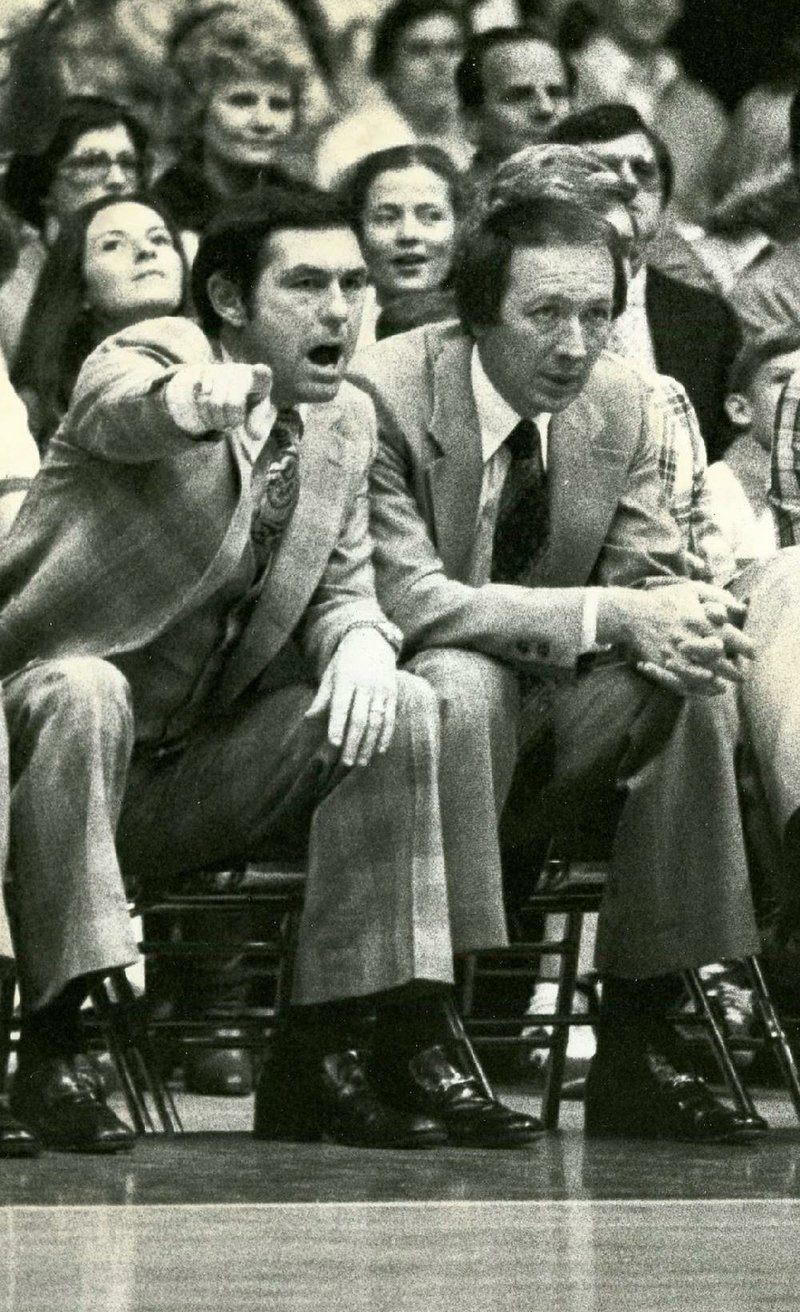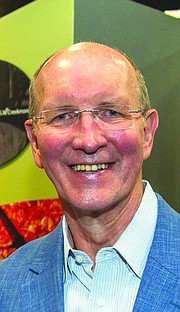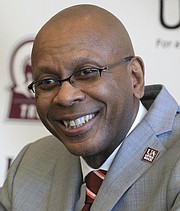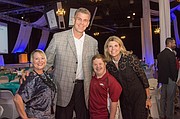FAYETTEVILLE -- When Eddie Sutton took the job as head men's basketball coach at the University of Arkansas, the Razorbacks' Barnhill Arena was far from a home-court advantage.
Really, it was far from a true basketball arena.
Home cooking
• The college basketball teams with the best home winning percentages from 1974-85:
TEAM ARENA PCT.
Arkansas Barnhill Arena .938
Kentucky Memorial Coliseum/Rupp Arena .907
North Carolina Carmichael Auditorium .907
UNLV Las Vegas CC/Thomas & Mack Center .901
UCLA Pauley Pavilion .885
Louisville Freedom Hall .882
Indiana Assembly Hall .854
Georgetown McDonough Gymnasium/Capital Centre .841
Houston Hofheinz Pavilion .839
Kansas Allen Fieldhouse .815
NC State Reynolds Coliseum .795
Duke Cameron Indoor Stadium .713
RESEARCH Matt Jones, Scottie Bordelon, Seth Campbell
Originally named Razorback Fieldhouse when it opened in 1955 (it was renamed for the late football coach and athletic director John Barnhill two years later), the building was constructed to give Arkansas' football team a locker room and indoor workout area as much as it was to house the basketball team.
There were 5,000 seats and many went unused each game. In order to get to that capacity, portable bleachers from the football stadium next door were placed on the south end of the arena in front of a sawdust workout area for the football team. A dirt track encircled the floor.
In-season basketball practice was conducted while offseason football conditioning was occurring just feet away. During basketball games, two arena workers would sweep sawdust off the floor that had been circulated by the heating unit.
"You almost needed to wear a mask to keep from choking because there was so much dust in the air," Sutton, who died May 23, said in 1993. "And when you walked into Barnhill at 7 o'clock of a game night, you could shoot a gun into the stands and not hit anybody."
Yet somehow from that, Sutton created one of the greatest home-court advantages in the country from the mid-1970s through the mid-1980s.
The same building that was home to Arkansas teams that had a combined home record of 115-80 under coaches Glen Rose, Duddy Waller and Lanny Van Eman in its first 19 years, was also home to teams that were a combined 198-23 in its final 19 years under Sutton and Nolan Richardson.
As good as Richardson's teams were at Barnhill (78-15), no coach had more success there than Sutton, who had a 120-8 record in 11 seasons.
Against Southwest Conference opponents, Sutton's teams were 79-6 at Barnhill, key in the Razorbacks winning five SWC regular-season championships.
Kentucky, North Carolina, UNLV and others had great home-court advantages during the Sutton era at Arkansas, but none won at home as frequently as the Razorbacks won inside Barnhill.
"The word got out that you just didn't want to come to Fayetteville to play," said Jim Counce, who played for Sutton from 1974-78, "that it was impossible for the visiting team to win there."
When Arkansas Athletic Director Frank Broyles interviewed Sutton at the 1974 Final Four in Greensboro, N.C., a promise was made to improve Barnhill. Sutton said he wanted it expanded to include 8,500 seats.
"People were wanting to have a basketball program, so we were able to raise enough money to put 9,000 seats in there," Broyles said in 2007.
Broyles' promise to Sutton was fulfilled in two phases over three years at a cost of around $8 million.
The first phase added 1,200 permanent seats to the south side in time for the 1976-77 season, when the Razorbacks were 26-2 overall and won all 11 games at Barnhill.
The second and most significant renovation was completed in 1979, a year after Sutton took the Razorbacks to the Final Four.
Beginning with a 95-89 double-overtime victory over SWC champion Texas A&M on Feb. 8, 1975, every game at Barnhill was a sellout.
The Razorbacks had a streak of 334 consecutive regular-season sellouts snapped in 2003, 10 years after they left Barnhill for the 19,200-seat Walton Arena. Thousands of fans were on waiting lists for season tickets after the move.
"I bet in all the games before Christmas in Coach Sutton's first year, there probably weren't more than 2,500 or 3,000 people there in the stands," Counce said. "But by the middle of our conference season that same year, you couldn't find a seat anywhere."
A pivotal victory at Barnhill came during Sutton's second season, when the Razorbacks defeated Houston 92-47 in the Cougars' first conference game as a member of the SWC.
The victory generated a significant appetite for Razorback basketball. Three nights later, Barnhill's 5,000 seats were full, but Arkansas blew a 13-point lead and lost to SMU on a last-second tip in.
It was the Razorbacks' last home loss for three years. They won 24 consecutive games at home and was ranked No. 1 for a time.
"A ticket to any game at Barnhill was a big deal back then because there weren't that many of them," Counce said.
With a real basketball arena and a team that played well enough to fill it up, Sutton's next step was to create an atmosphere. In his early days at Arkansas, Sutton observed "show-me-something" fans that waited for big moments to make noise.
Sutton wanted a crowd that understood momentum and their place in helping to create or sustain it. He needed to teach them which moments were important, but couldn't while he was coaching a game.
The next best thing would be teach someone else, and let that person teach the crowd. He identified the perfect candidate: a graduate assistant in the music department whose responsibility was to lead a pep band for home basketball games.
The GA was Jim Robken, and the Hogwild Band was born.
Sutton told him: "There are times I need the crowd and I need you to keep them in the game. When the opposing coach calls a timeout to stop us on a run, I need the crowd to go. Keep them in the game."
In the early years, Robken had trouble finding enough volunteers to play in the band. But by the early 1980s, there were more volunteers than the 100 spots available in the band section.
From atop a perch in the corner of the arena, Robken's goal was simple: To generate noise, and lots of it.
When he sensed a key moment in the game, Robken would strike up the "William Tell Overture" and sprint around the arena floor and up the the aisles to keep the crowd engaged during a timeout.
"The crowds in Barnhill and Jim Robken won a lot of basketball games for us," said Darrell Walker, who played at Arkansas from 1980-83 and was an All-American as a senior. "The fans were right on top of you and they let the opposing team know what they were going to be in for that night. It was a special place."
Sutton once joked if he ever left Arkansas, he would take Robken with him.
Robken stayed behind when Sutton left for Kentucky in 1985.
"He was good about the periphery of everything," Robken said of Sutton. "He never got a technical that he didn't need to get. He planned those things, whether it was a technical to let his team know he was supporting them, or a technical to get the fans back in the game.
"He told me, 'When I start taking off my jacket, get ready.' I said, 'OK, I'm watching you. We got this.' He'd take off that jacket and I'd turn around to the band and say, 'Get set. Here we go. It's about to happen.'
"He taught me the magic of having all the fans doing stuff at the right time, and the timing of it. It was just incredible. The first few times whenever we had the crowd going so loud that you couldn't even talk to each other, it was just amazing. We just tried to re-create it every time."
By 1981, Sutton declared the Razorbacks had the best home atmosphere in the SWC.
"There's no place where the fans matured more than they did at Barnhill," Sutton said. "The fans used to sit on their hands. As time went on, the crowd sensed when the team was in trouble and helped create an atmosphere that rallied the team."
Joe Kleine, who transferred to Arkansas from Notre Dame in 1981, credited Robken with making Barnhill the most intimidating arena he has seen. The noise could be deafening.
"It was like when you saw film of nuclear testing under water," Kleine said. "You'd see the bubble come up from the explosion. That was Barnhill Arena -- all that sound trying to get out, but the water kept it in."
The notable victories were numerous. Among the best remembered under Sutton:
• Arkansas 93, Texas A&M 91, Jan. 24, 1976: Sidney Moncrief took a full-court pass from Jack Schulte and made a layup as time expired in double overtime.
• Arkansas 60, Texas 59, Feb. 2, 1980: U.S. Reed hit a 20-foot shot at the buzzer to give the Razorbacks their fourth consecutive victory over the Longhorns.
• Arkansas 67, Houston 66, Jan. 23, 1982: Scott Hastings made a long, game-winning shot over Akeem Olajuwon in the closing seconds.
• Arkansas 73, Houston 68, March 4, 1984: Joe Kleine out-dueled Olajuwon with a 22-point effort and the Razorbacks snapped the No. 2 Cougars' 39-game SWC winning streak.
• Arkansas 69, SMU 66, Feb. 6, 1985: The No. 4 Mustangs were the second AP top-four team to lose at Barnhill in 11 months.
Through the expansions, Barnhill retained the feel of a small fieldhouse. Players were never far from the crowd.
"I think everyone probably has in their experience an old high school gym with 2,000 or 3,000 seats, and the impact that can have on the court with how close you are, how loud things can get in a place like that," Robken said. "Barnhill was about 9,000, but it kept all the intimacy. I love the way it was designed with the seats that went all the way down the court so the fans were right there."
Opponents, on the other hand, hated it. In Sutton's 11 seasons, the Razorbacks played only 43 nonconference games in Fayetteville.
The other 38 nonconference home games were played at the Pine Bluff Convention Center or Barton Coliseum in Little Rock. That was part strategy to take the team to fans in other parts of the state, but partly out of necessity.
On Dec. 20, 1976, the Razorbacks defeated Kansas State 80-65 in Fayetteville. The Wildcats won the Big 8 title that season and lost by one point to eventual national champion Marquette in the NCAA Tournament's round of 16.
"We just beat them like a drum," Counce said. "The word after that was you just couldn't get a good nonconference opponent to come to Fayetteville to play."
Two days before defeating Kansas State, the Razorbacks defeated Kansas 67-63 at Allen Fieldhouse in the first game of a home-and-home series. The following year the Jayhawks' return game was played at Barton Coliseum in Little Rock, where the Razorbacks won 78-72.
"Kansas wouldn't come to Fayetteville," Counce said. "We had to play them in Lawrence, but they returned the game in Little Rock."
After that some of the Razorbacks' most high-profile games were played away from Fayetteville.
In December 1984, the Razorbacks held on for a close 70-66 victory over Tulsa at Barton Coliseum. The Golden Hurricane were coached by Richardson, who replaced Sutton at Arkansas four months later.
There was not a more high-profile instance of the Razorbacks playing a home basketball game away from Fayetteville than when they hosted undefeated and No. 1 North Carolina at Pine Bluff on Feb. 12, 1984. Arkansas won the game 65-64 after Charles Balentine hit a go-ahead floater in the closing seconds.
Sutton had a 36-4 record at Little Rock and Pine Bluff.
"Coach Sutton established the quality of the teams at Arkansas, but he also did it in a way that promoted all the fan fervor and all the support from the entire state," Counce said. "It was not unusual for a lot of people to travel from Little Rock up to Fayetteville for a nighttime midweek game back in Coach Sutton's day, and then turn right around and drive back to Little Rock after the game. I realize that still goes on now, but that was so unusual when it started."
Five years after he left Arkansas for Kentucky -- and a year after resigning as the Wildcats' coach -- Sutton returned to Barnhill in March 1990 for the ceremony retiring the number of his greatest player, Sidney Moncrief.
Sutton had upset some Arkansas fans in 1985 with a comment that he would have "crawled to Kentucky" to interview for the job there. But when he was introduced on the Barnhill floor in 1990 with Moncrief, Ron Brewer and Marvin Delph, Sutton received a loud ovation.
On the night of the Razorbacks' final basketball game at Barnhill in March 1993, Sutton was among the 9,660 in attendance. He was coach at Oklahoma State by that time and had a game to coach the following night, but he wouldn't miss such an occasion.
"Oh, the electricity here," Sutton said that night. "I'd forgotten how it was. When I stepped onto this court, my heart pounded like it hadn't in years."
The Razorbacks' 88-75 victory over LSU that night was Arkansas' 313th at Barnhill in 38 seasons.
"When you're trying to build a program, the first thing you have to do is win your home games," Kleine said. "In any sport, you can't be a great team unless you have home dominance.
"I think how they constructed that arena, how Coach Sutton got Jim Robken involved and the students involved and then recruited phenomenal players, that's the recipe for that kind of a record at home. Great coaches are able to do that."
In the fall of 1993, Arkansas opened Walton Arena. The Razorbacks won a national championship in 1994, were runner-up in 1995 and every ticket sold in Walton Arena's first 10 seasons.
The Razorbacks played at Schmitty's Barn in 1923-37; Razorback Fieldhouse in 1937-55; Barnhill Arena in 1955-93; and Walton Arena since 1993.
Although twice the capacity, the new arena was built to copy some features of Barnhill, notably the noise level. Arkansas' media guide touted Walton Arena as having more seats in less space than any other arena in the world.
The Razorbacks have maintained a strong home-court advantage since leaving Barnhill. In 27 seasons at Walton Arena, Arkansas has won 80.8 percent of its home games.
At Walton, the often-unranked Razorbacks have a record of 38-25 vs. ranked teams, including 12-8 vs. teams ranked in the top 10.
For many who experienced it, though, nothing will ever match the invincibility the Razorbacks felt inside Barnhill.
"Hey, I love Bud Walton. I think it was needed because everybody was upgrading their facilities," Walker said. "But Barnhill was the loudest, most deafening place I've ever been in. It was unbelievable."
In December 2003, Sutton brought his Oklahoma State team to Walton Arena, where they defeated the Razorbacks 73-56. It was Sutton's 121st victory in 129 games in Fayetteville.
"It was a little eerie going out there when they started calling those Hogs and playing the fight song," Sutton said. "I'll tell you, it brought back a lot of wonderful memories of the 11 years I coached here."
Sutton went 4-0 against Arkansas as OSU's coach, but the 2003 game was the only one he coached against the Razorbacks in Fayetteville.
The rest of Sutton's trips back to Fayetteville were primarily as a fan or honored guest, even after his health began to fail and left him bound to a wheelchair.
In 2016, a banner with Sutton's name was raised in the rafters of Walton Arena. Last year, the practice gym for the Razorbacks was named after Sutton.
"He loved coaching the Razorbacks. He always took so much pride in that program," said Sean Sutton, the second of Eddie Sutton's three sons. "In a lot of ways, he viewed Arkansas basketball as his fourth child. He spent so much time and effort trying to build that program."
Information for this article was provided by Bob Holt, Scott Cain, Stephen Caldwell, Harry King and the late Orville Henry.
Sports on 05/31/2020



